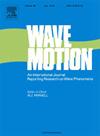General rogue waves, breathers and hybrid structures of the coupled Boussinesq system
IF 2.5
3区 物理与天体物理
Q2 ACOUSTICS
引用次数: 0
Abstract
In this paper, we concentrate on the rogue waves, breathers and hybrid solutions of the coupled Boussinesq system via the Kadomtsev–Petviashvili (KP) hierarchy reduction method. We construct the Gram determinant solutions for a -dimensional bilinear system in the KP hierarchy which can be reduced to the coupled Boussinesq system. By considering the dimension-reduction condition, the general high-order rogue wave solutions expressed by derivatives with respect to parameters and are derived. For simplicity, the expressions of the rogue waves are replaced by purely algebraic ones with the help of the known Schur polynomials. The rogue waves from first till fourth order and their dynamic properties are numerically investigated. The structures of the th-order rogue waves contain first-order rogue waves. As more free parameters appear, the number of patterns increases. The breather solutions are obtained through setting specific parameter conditions in soliton solutions. Then first- and second-order breathers are attained and their dynamics are analyzed numerically. Three different arrangements for the first-order breathers as well as three types of second-order breather waves including interacting waves, parallel waves and coincident waves are displayed. The hybrid solutions containing first-order breather as well as first- and second-order solitons are given with dynamic analysis. A similar way can be used to obtain the th-order rogue waves and the th-order breathers. The method used in the paper can be extended to other integrable equations theoretically.
耦合Boussinesq体系的一般异常波、呼吸波和杂化结构
本文利用Kadomtsev-Petviashvili (KP)层次约简方法研究了耦合Boussinesq系统的异常波、呼吸波和混合解。构造了KP层次中(2+1)维双线性系统的Gram行列式解,该系统可简化为耦合的Boussinesq系统。考虑降维条件,导出了关于参数p和q的导数表示的一般高阶异常波解。为简单起见,在已知的舒尔多项式的帮助下,将异常波的表达式替换为纯粹的代数表达式。数值研究了一阶到四阶的异常波及其动力特性。N阶异常波结构包含N(N+1)2个一阶异常波。随着更多自由参数的出现,模式的数量也会增加。通过在孤子解中设置特定的参数条件,得到了呼吸解。得到了一阶和二阶呼吸体,并对其动力学进行了数值分析。显示了一阶呼吸波的三种不同排列以及三种类型的二阶呼吸波,包括相互作用波、平行波和重合波。给出了含一阶呼吸子和一阶、二阶孤子的混合解,并进行了动力学分析。用类似的方法可以得到n阶异常波和m阶呼吸波。本文所采用的方法在理论上可以推广到其他可积方程。
本文章由计算机程序翻译,如有差异,请以英文原文为准。
求助全文
约1分钟内获得全文
求助全文
来源期刊

Wave Motion
物理-力学
CiteScore
4.10
自引率
8.30%
发文量
118
审稿时长
3 months
期刊介绍:
Wave Motion is devoted to the cross fertilization of ideas, and to stimulating interaction between workers in various research areas in which wave propagation phenomena play a dominant role. The description and analysis of wave propagation phenomena provides a unifying thread connecting diverse areas of engineering and the physical sciences such as acoustics, optics, geophysics, seismology, electromagnetic theory, solid and fluid mechanics.
The journal publishes papers on analytical, numerical and experimental methods. Papers that address fundamentally new topics in wave phenomena or develop wave propagation methods for solving direct and inverse problems are of interest to the journal.
 求助内容:
求助内容: 应助结果提醒方式:
应助结果提醒方式:


